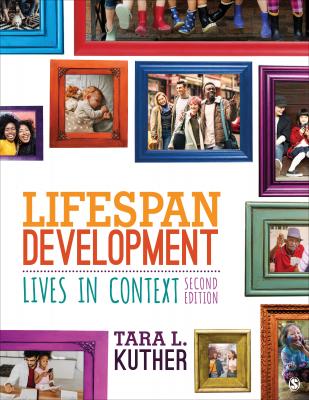ТОП просматриваемых книг сайта:
Lifespan Development. Tara L. Kuther
Читать онлайн.Название Lifespan Development
Год выпуска 0
isbn 9781544332253
Автор произведения Tara L. Kuther
Издательство Ingram
8 Part V AdolescenceChapter 11: Physical and Cognitive Development in AdolescenceConceptions of AdolescenceIs Adolescence a Period of Storm and Stress?Adolescent MoodinessPhysical Development in AdolescencePubertyChanges in Body Size and ShapeSexual CharacteristicsSexual MaturationIndividual Differences in the Timing of Pubertal MaturationPsychosocial Effects of Pubertal TimingPuberty and Sleep PatternsNutrition and DevelopmentBrain Development in AdolescenceSocioemotional PerceptionRisk TakingAdolescent Cognitive DevelopmentPiaget’s Cognitive-Developmental Theory: Formal Operational ReasoningInformation Processing TheoryAttention, Response Inhibition, and Working MemoryMetacognition and Scientific ReasoningImplications of Adolescent ThinkingAdolescent EgocentrismDecision MakingAdolescent Moral DevelopmentPostconventional Moral ReasoningSocial Interaction and Moral ReasoningGender and Moral ReasoningCulture and Moral ReasoningMoral Reasoning and BehaviorSchools and Academic Functioning in AdolescenceSchool TransitionsSchool DropoutParenting and Academic CompetenceChapter 12: Socioemotional Development in AdolescencePsychosocial Development: The Changing SelfSelf-ConceptSelf-EsteemIdentityIdentity StatusesInfluences on Identity DevelopmentOutcomes Associated With Identity DevelopmentEthnic IdentityAdolescents and Their FamiliesParent–Adolescent ConflictParentingParental MonitoringAdolescents and Their PeersFriendshipsCliques and CrowdsPeer ConformityDatingAdolescent SexualitySexual ActivityLesbian, Gay, Bisexual, and Transgender AdolescentsContraceptive UseSexually Transmitted InfectionsAdolescent PregnancyProblems in AdolescenceDepression and SuicideEating DisordersAlcohol and Substance UseDelinquency
9 Part VI Emerging And Early AdulthoodChapter 13: Physical and Cognitive Development in Emerging and Early AdulthoodEmerging Adulthood: Transition to AdulthoodMarkers of Emerging AdulthoodContextual Nature of Emerging AdulthoodPhysical Development in Emerging and Early AdulthoodPhysical ChangesFertility and Reproductive CapacityHealth, Fitness, and Wellness in Emerging and Early AdulthoodOverweight and ObesityPhysical ActivitySexual ActivitySexual CoercionSubstance AbuseAlcohol Use and AbuseMarijuanaTobaccoCognitive Development in Emerging and Early AdulthoodPostformal ReasoningPragmatic Thought and Cognitive-Affective ComplexityEvaluating Cognitive-Developmental Approaches to Adult DevelopmentEducation and Development in Emerging and Early AdulthoodDevelopmental Impact of Attending CollegeFirst-Generation College StudentsNontraditional College StudentsThe Forgotten ThirdCareer Development in Emerging and Early AdulthoodOccupational StagesInfluences on Vocational ChoiceTransition to WorkDiversity in the WorkplaceWork and FamilyChapter 14: Socioemotional Development in Emerging and Early AdulthoodPsychosocial Development in Emerging Adulthood and Early AdulthoodIdentity Versus Role ConfusionIntimacy Versus IsolationThe Social ClockRelationships in Psychosocial Development in Emerging and Early AdulthoodFriendshipRomantic RelationshipsMate SelectionComponents of LoveIntimate Partner ViolenceLifestyles and Romantic PartnershipsSinglehoodCohabitationMarriageSame-Sex MarriageDivorceParenthood in Early AdulthoodBecoming a ParentNever-Married Single ParentSame-Sex ParentsStepparentsChildlessness
10 Part VII Middle AdulthoodChapter 15: Physical and Cognitive Development in Middle AdulthoodPhysical Development in Middle AdulthoodTheories of Aging: What Causes Aging?Sensory AgingVisionHearingSkin, Muscular, and Skeletal AgingReproductive AgingReproductive Changes in WomenReproductive Changes in MenHealth in Middle AdulthoodCommon IllnessesCancerCardiovascular DiseaseDiabetesStressHardiness and HealthSexual ActivityIntellectual Abilities in Middle AdulthoodFluid and Crystallized IntelligenceIntelligence Over the Adult YearsCognitive Development in Middle AdulthoodAttentionMemoryProcessing SpeedExpertiseChapter 16: Socioemotional Development in Middle AdulthoodPsychosocial Development in Middle AdulthoodErikson’s Generativity Versus StagnationLevinson’s Seasons of LifeMidlife CrisisThe Self in Middle AdulthoodSelf-Concept in Middle AdulthoodSubjective AgePossible SelvesGender Identity in Middle AdulthoodSelf and Well-Being in Middle AdulthoodPersonality in Middle AdulthoodRelationships in Middle AdulthoodFriendshipsMarriage and DivorceParent–Child RelationshipsParents to Adult ChildrenParents to Infants and Young ChildrenGrandparenthoodCaring for Aging ParentsCareers in Middle AdulthoodJob SatisfactionPlanning for Retirement
11 Part VIII Late AdulthoodChapter 17: Physical and Cognitive Development in Late AdulthoodPhysical Development in Late AdulthoodAppearanceBrain AgingThe SensesVisionHearingSmell and TasteCardiovascular, Respiratory, and Immune SystemsMotor AgingHealth in Late AdulthoodNutritionExerciseChronic IllnessArthritisOsteoporosisInjuriesMotor Vehicle AccidentsFallsDementia in Late AdulthoodAlzheimer’s DiseaseDiagnosis of Alzheimer’s DiseaseProgression of Alzheimer’s DiseaseRisk Factors for Alzheimer’s DiseaseVascular DementiaParkinson’s DiseaseLewy Body DementiaDeliriumCognitive Development in Late AdulthoodAttentionWorking MemoryContext, Task Demands, and Memory PerformanceEmotion and Working MemoryLong-Term MemoryAging and LanguageProblem Solving and WisdomInfluences on Cognitive Change in AdulthoodChapter 18: Socioemotional Development in Late AdulthoodThe Self in Late AdulthoodSubjective AgeReminiscence and Life ReviewEgo IntegrityPersonalityReligiosity in Late AdulthoodLate Adulthood and Social ContextsSocial Support in Older AdulthoodAging and the Social WorldDisengagement, Activity, and Continuity TheoriesSocioemotional Selectivity TheoryNeighborhoodsAging in PlaceResidential CommunitiesNursing HomesRelationships in Late AdulthoodFriendshipsSibling RelationshipsMarriage, Divorce, and CohabitationMarriageDivorce and RemarriageCohabitationSexuality in Late AdulthoodRelationships With Adult Children and GrandchildrenElder MaltreatmentRetirementDeciding to RetireTransition to Retirement and AdjustmentInfluences on Retirement Adjustment
12 Part IX EndingsChapter 19: Death and DyingPatterns of Mortality and Defining DeathMortalityDefining DeathEnd-of-Life IssuesAdvance DirectivesEuthanasiaPhysician-Assisted SuicideHospiceConceptions of Death Across the LifespanChildren’s Understanding of DeathAdolescents’ Understanding of DeathAdults’ Understanding of DeathDying and the Experience of DeathThe Dying ProcessEmotional Reactions to DyingThe Experience of One’s DeathThe Dying ChildThe Dying AdolescentThe Dying AdultBereavement and GriefThe Grief ProcessModels of GrievingContextual Influences on the Grief ProcessAdjusting to the Death of a Loved OneLosing a SpouseLosing a ChildLosing a ParentBereavement in Childhood and AdolescenceBereavement in ChildhoodBereavement in Adolescence
13 Glossary
14 References
15 Name Index
Preface
Lifespan Development: Lives in Context has its origins in 20-plus years of class discussions about the nature of development in which my students have questioned, challenged, and inspired me. My goal in writing this text is to explain the sophisticated interactions that constitute

